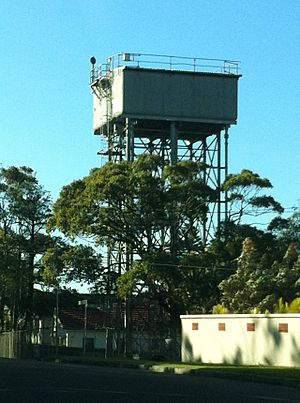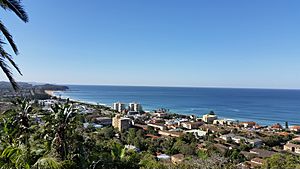Collaroy Plateau facts for kids
Quick facts for kids Collaroy PlateauNorthern Beaches, New South Wales |
|||||||||||||||
|---|---|---|---|---|---|---|---|---|---|---|---|---|---|---|---|

View to the north from Collaroy Plateau
|
|||||||||||||||
| Population | 4,767 (2016 census) | ||||||||||||||
| Postcode(s) | 2097 | ||||||||||||||
| Elevation | 91 m (299 ft) | ||||||||||||||
| Location | 22 km (14 mi) north-east of Sydney CBD | ||||||||||||||
| LGA(s) | Northern Beaches Council | ||||||||||||||
| State electorate(s) | Pittwater, Wakehurst | ||||||||||||||
| Federal Division(s) | Mackellar | ||||||||||||||
|
|||||||||||||||
Collaroy Plateau is a suburb located in northern Sydney, New South Wales, Australia. It sits about 22 kilometres north-east of the main city centre of Sydney. This area is part of the Northern Beaches region and is managed by the Northern Beaches Council.
Collaroy Plateau is famous for its amazing views. From here, you can see many of Sydney's beautiful beaches. These include Collaroy Beach, Long Reef Beach, and Narrabeen Beach. You can also see the lovely Narrabeen Lagoon.
For a while, Collaroy Plateau was considered a part of Collaroy. But in 2011, after people in the community worked hard to make it happen, it became its own suburb again. This shows how much local residents love their area!
Contents
What's in a Name?
The name Collaroy comes from an Aboriginal word meaning "big reeds." Long ago, this area was part of Narrabeen.
The suburb got its name from a ship called the "Collaroy." In 1881, this steamer ship got stuck on Long Reef, which is near the southern part of the suburb. Many people came to see the shipwreck. The ship's anchor can still be found at Narrabeen Primary School today.
Important Places
Collaroy Reservoir
The Collaroy Reservoir was a special water tank built for railways. It was an important part of Sydney's water system. Even though it was taken down in 2018, it was once a key landmark.
Collaroy Trig Station
A "trig station" is a special marker used to create accurate maps. "Trig" is short for trigonometry, a type of math used to measure distances and angles. These stations are often on high places like hills or tall buildings.
The Collaroy Trig Station (called TP5865) was located on top of the old Collaroy Reservoir. It helped mapmakers understand the area better. Today, modern technology like CORSnet-NSW stations helps with mapping.
Collaroy Radar Station (WWII)
During World War II, a very important radar station was built on Collaroy Plateau. It was called 54RS. Radar helps detect planes and ships.
In 1942, American forces brought new radar devices to Australia. The Collaroy Plateau site was chosen because it was close to a laboratory. This made it a great place to test new radar technology. It was also used to train radar operators and as a rest spot for airmen. The station stopped operating in 1947.
Amazing Views
Collaroy Plateau offers incredible views of the Northern Beaches. Imagine standing high up and seeing Collaroy Beach, Long Reef Beach, Narrabeen Beach, and Narrabeen Lagoon all at once!
In 1921, someone described the view from the "Superb View Estate" on the heights above Collaroy Beach. They said you could see the Hawkesbury River to the north and Manly, South Head, and Bondi to the south. It truly is a superb view!
Famous People from Collaroy Plateau
Joseph Lade Pawsey
Joseph Lade Pawsey (1908–1962) was an Australian scientist. On October 3, 1945, he made history at the Radar Station on Collaroy Plateau. He successfully detected radio waves coming from the sun!
His work was very important. It led to the creation of modern technologies like Wi-Fi that we use every day. He became a leader in radio astronomy.
Frank Hurley
Frank Hurley (1885–1962) was an amazing adventurer, photographer, and filmmaker. He was born in Sydney and later lived on Collaroy Plateau. He passed away at his home there in 1962.
Frank Hurley took many famous photographs, including some of the beautiful views from Collaroy Plateau. You can find his work online, like his "Sunrise across lagoon from home window at Collaroy Plateau."
Ted Dellit, a WWII Radar Veteran
Ted Dellit lived on Collaroy Plateau for many years starting in 1961. He was a veteran of World War II, working with radar.
Ted wrote a highly respected book called "Who Were They?, The Royal Australian Air Force on Collaroy Plateau in the Second World War." He also helped make sure that copies of radar unit histories were sent to museums. Ted was very active in his community, helping with the RAAF Association and local school and sports clubs.
Places to Explore
Collaroy Plateau has several open public spaces where you can enjoy nature and relax:
- Edgar Gornall Wildflower Garden
- McLeans Lookout
- Plateau Park
- Anzac Avenue Reserve
Local Nature

The Warringah area, which includes Collaroy Plateau, is home to over 900 different types of native plants and trees. These plants grow in various environments, from sandy coastal areas to rocky plateaus.
Collaroy Plateau has "dry sclerophyll forests." These forests have many unique Australian plants like waratahs, banksias, wattles, and tea-trees. The soil here is often sandy and not very fertile, but these plants are perfectly adapted to it!
Community Life
Transport
Most people in Collaroy Plateau use private cars to get around. However, there are also public buses available to help you travel to other areas.
Schools and Churches
Collaroy Plateau has several schools and learning centres for children:
- Collaroy Plateau Primary School
- Collaroy Plateau Swim School
- Sally's Family Day Care
- Collaroy Plateau Community Kindergarten
- Owl & The Pussycat Pre School
- Collaroy Plateau Early Learning Centre
- Little Diggers Preschool on the Plateau
- Collaroy Plateau OOSH (Out Of School Hours care)
There are also churches in the area:
- Saints Paul and Reweis Coptic Orthodox Church
- Church of St Rose
Sport
Collaroy Plateau Cricket Club
The Collaroy Plateau Cricket Club started in 1955. It's one of the biggest cricket clubs on the Northern Beaches! They have about 25 junior and senior teams. Many young players from this club have gone on to play at higher levels of cricket.
The club's symbol is the Collaroy Plateau Water Tower, which is the old Collaroy Reservoir. Their home ground is Vic Huxley Oval, located at Collaroy Plateau Park.




